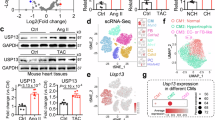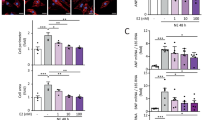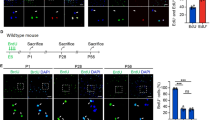Abstract
Myocardial hypertrophy is one of the most prominent features of heart failure. SET domain-containing protein 7 (Setd7), a catalytic enzyme responsible for histone H3K4 methylation, has been implicated in various cardiac diseases. In this study we investigated whether Setd7 contributed to the development of cardiac hypertrophy. Male mice were subjected to a hypobaric hypoxic environment for 8 weeks; neonatal rat cardiomyocytes (NRCMs) exposed to hypoxia for 6 h. We showed that hypoxic stimulation significantly upregulated the expression levels of Setd7 along with the expression of hypertrophic markers ANP and BNP in NRCMs. By conducting loss- and gain-of-function assays, we demonstrated that Setd7 modulated the hypertrophic and inflammatory markers in hypoxic cardiomyocytes. We further revealed that Setd7-mediated activation of E2F1 (E2 promoter binding factor 1) triggered the expression of E3 ubiquitin protein ligases WWP2, which catalyzed the ubiquitination and degradation of glutathione peroxidase 4 (GPx4), a critical lipid peroxide-reducing enzyme. This degradation drove extensive lipid peroxidation, thereby exacerbating pathological cardiac hypertrophy. Notably, GPx4 inhibition by ras-selective lethal small molecule 3 (RSL3) abolished the antihypertrophic effects of Setd7 knockdown in cardiomyocytes, underscoring the pivotal role of lipid peroxidation in Setd7-mediated hypertrophic responses. In summary, Setd7 promotes hypoxia-induced cardiac hypertrophy through the Setd7-E2F1-WWP2-GPx4 signaling pathway, suggesting that targeting Setd7 is a promising therapeutic strategy to alleviate hypoxia-induced myocardial hypertrophy.
Graphical Abstract

Setd7 increases the enrichment of H3K4me2/3 on the E2F1 promoter region, mediating the transcriptional activation of E2F1. E2F1 further promotes WWP2 expression to trigger ubiquitination and degradation of GPx4 protein, ultimately causing widespread lipid peroxidation and boosting pathological cardiac hypertrophy.
This is a preview of subscription content, access via your institution
Access options
Subscribe to this journal
Receive 12 print issues and online access
$259.00 per year
only $21.58 per issue
Buy this article
- Purchase on SpringerLink
- Instant access to full article PDF
Prices may be subject to local taxes which are calculated during checkout







Similar content being viewed by others
References
Nakamura M, Sadoshima J. Mechanisms of physiological and pathological cardiac hypertrophy. Nat Rev Cardiol. 2018;15:387–407.
Groenewegen A, Rutten FH, Mosterd A, Hoes AW. Epidemiology of heart failure. Eur J Heart Fail. 2020;22:1342–56.
Adamo L, Rocha-Resende C, Prabhu SD, Mann DL. Reappraising the role of inflammation in heart failure. Nat Rev Cardiol. 2020;17:269–85.
Jiang F, Yin K, Wu K, Zhang M, Wang S, Cheng H, et al. The mechanosensitive Piezo1 channel mediates heart mechano-chemo transduction. Nat Commun. 2021;12:869.
Savarese G, Becher PM, Lund LH, Seferovic P, Rosano GMC, Coats AJS. Global burden of heart failure: a comprehensive and updated review of epidemiology. Cardiovasc Res. 2023;118:3272–87.
Yin H, Xu L, Porter NA. Free radical lipid peroxidation: mechanisms and analysis. Chem Rev. 2011;111:5944–72.
Gaschler MM, Stockwell BR. Lipid peroxidation in cell death. Biochem Biophys Res Commun. 2017;482:419–25.
Chen F, Kang R, Tang D, Liu J. Ferroptosis: principles and significance in health and disease. J Hematol Oncol. 2024;17:41.
Dixon SJ, Lemberg KM, Lamprecht MR, Skouta R, Zaitsev EM, Gleason CE, et al. Ferroptosis: an iron-dependent form of nonapoptotic cell death. Cell. 2012;149:1060–72.
Stockwell BR, Friedmann Angeli JP, Bayir H, Bush AI, Conrad M, Dixon SJ, et al. Ferroptosis: a regulated cell death nexus linking metabolism, redox biology, and disease. Cell. 2017;171:273–85.
Zhang Q, Luo Y, Peng L, Rong X, Liu Y, Li J, et al. Ferroptosis in cardiovascular diseases: role and mechanism. Cell Biosci. 2023;13:226.
Liu X, Chen Z, Xu C, Leng X, Cao H, Ouyang G, et al. Repression of hypoxia-inducible factor α signaling by Set7-mediated methylation. Nucleic Acids Res. 2015;43:5081–98.
Lv J, Wu Q, Li K, Bai K, Yu H, Zhuang J, et al. Lysine N-methyltransferase SETD7 promotes bladder cancer progression and immune escape via STAT3/PD-L1 cascade. Int J Biol Sci. 2023;19:3744–61.
Oudhoff MJ, Braam MJS, Freeman SA, Wong D, Rattray DG, Wang J, et al. SETD7 controls intestinal regeneration and tumorigenesis by regulating Wnt/β-Catenin and Hippo/YAP Signaling. Dev Cell. 2016;37:47–57.
Ambrosini S, Montecucco F, Kolijn D, Pedicino D, Akhmedov A, Mohammed SA, et al. Methylation of the Hippo effector YAP by the methyltransferase SETD7 drives myocardial ischaemic injury: a translational study. Cardiovasc Res. 2023;118:3374–85.
Wang J, Deng B, Liu Q, Huang Y, Chen W, Li J, et al. Pyroptosis and ferroptosis induced by mixed lineage kinase 3 (MLK3) signaling in cardiomyocytes are essential for myocardial fibrosis in response to pressure overload. Cell Death Dis. 2020;11:574.
Yin Z, Ding G, Chen X, Qin X, Xu H, Zeng B, et al. Beclin1 haploinsufficiency rescues low ambient temperature-induced cardiac remodeling and contractile dysfunction through inhibition of ferroptosis and mitochondrial injury. Metabolism. 2020;113:154397.
Park TJ, Park JH, Lee GS, Lee JY, Shin JH, Kim MW, et al. Quantitative proteomic analyses reveal that GPX4 downregulation during myocardial infarction contributes to ferroptosis in cardiomyocytes. Cell Death Dis. 2019;10:835.
Wang Y, Yan S, Liu X, Deng F, Wang P, Yang L, et al. PRMT4 promotes ferroptosis to aggravate doxorubicin-induced cardiomyopathy via inhibition of the Nrf2/GPX4 pathway. Cell Death Differ. 2022;29:1982–95.
Yang WS, SriRamaratnam R, Welsch ME, Shimada K, Skouta R, Viswanathan VS, et al. Regulation of ferroptotic cancer cell death by GPX4. Cell. 2014;156:317–31.
Liu Q, Song T, Chen B, Zhang J, Li W. Ferroptosis of brain microvascular endothelial cells contributes to hypoxia-induced blood-brain barrier injury. FASEB J. 2023;37:e22874.
Cheng K, Yang G, Huang M, Huang Y, Wang C. Exogenous 1,25(OH)(2)D(3)/VD(3) counteracts RSL3-Induced ferroptosis by enhancing antioxidant capacity and regulating iron ion transport: Using zebrafish as a model. Chem Biol Interact. 2024;387:110828.
Chou PC, Liu CM, Weng CH, Yang KC, Cheng ML, Lin YC, et al. Fibroblasts drive metabolic reprogramming in pacemaker cardiomyocytes. Circ Res. 2022;131:6–20.
Dassanayaka S, Brittian KR, Jurkovic A, Higgins LA, Audam TN, Long BW, et al. E2f1 deletion attenuates infarct-induced ventricular remodeling without affecting O-GlcNAcylation. Basic Res Cardiol. 2019;114:28.
Ea CK, Baltimore D. Regulation of NF-kappaB activity through lysine monomethylation of p65. Proc Natl Acad Sci USA. 2009;106:18972–7.
Kontaki H, Talianidis I. Lysine methylation regulates E2F1-induced cell death. Mol Cell. 2010;39:152–60.
Kouskouti A, Scheer E, Staub A, Tora L, Talianidis I. Gene-specific modulation of TAF10 function by SET9-mediated methylation. Mol Cell. 2004;14:175–82.
Wang H, Cao R, Xia L, Erdjument-Bromage H, Borchers C, Tempst P, et al. Purification and functional characterization of a histone H3-lysine 4-specific methyltransferase. Mol Cell. 2001;8:1207–17.
Chuikov S, Kurash JK, Wilson JR, Xiao B, Justin N, Ivanov GS, et al. Regulation of p53 activity through lysine methylation. Nature. 2004;432:353–60.
Torella D, Salerno N, Cianflone E. SETD7 methyltransferase is a key druggable target for effective cardioprotection from myocardial ischaemic injury. Cardiovasc Res. 2023;118:3269–71.
Mohammed SA, Gorica E, Albiero M, Karsai G, Mengozzi A, Caravaggi CM, et al. Targeting SETD7 rescues diabetes-induced impairment of angiogenic response by transcriptional repression of semaphorin-3G. Diabetes. 2025;74:969–82.
Wang J, Tan S, Zhang Y, Xu J, Li Y, Cheng Q, et al. Set7/9 aggravates ischemic brain injury via enhancing glutamine metabolism in a blocking Sirt5 manner. Cell Death Differ. 2024;31:511–23.
Bichmann M, Prat Oriol N, Ercan-Herbst E, Schöndorf DC, Gomez Ramos B, Schwärzler V, et al. SETD7-mediated monomethylation is enriched on soluble Tau in Alzheimer’s disease. Mol Neurodegener. 2021;16:46.
Peng L, Song Z, Zhao C, Abuduwufuer K, Wang Y, Wen Z, et al. Increased soluble epoxide hydrolase activity positively correlates with mortality in heart failure patients with preserved ejection fraction: evidence from metabolomics. Phenomics. 2023;3:34–49.
Alzahrani AM, Rajendran P, Veeraraghavan VP, Hanieh H. Cardiac protective effect of kirenol against doxorubicin-induced cardiac hypertrophy in H9c2 cells through Nrf2 signaling via PI3K/AKT pathways. Int J Mol Sci. 2021;22:3269.
Baba SP, Zhang D, Singh M, Dassanayaka S, Xie Z, Jagatheesan G, et al. Deficiency of aldose reductase exacerbates early pressure overload-induced cardiac dysfunction and autophagy in mice. J Mol Cell Cardiol. 2018;118:183–92.
Seiler A, Schneider M, Förster H, Roth S, Wirth EK, Culmsee C, et al. Glutathione peroxidase 4 senses and translates oxidative stress into 12/15-lipoxygenase dependent- and AIF-mediated cell death. Cell Metab. 2008;8:237–48.
Sun X, Zhang Q, Lin X, Shu P, Gao X, Shen K. Imatinib induces ferroptosis in gastrointestinal stromal tumors by promoting STUB1-mediated GPX4 ubiquitination. Cell Death Dis. 2023;14:839.
Orian L, Mauri P, Roveri A, Toppo S, Benazzi L, Bosello-Travain V, et al. Selenocysteine oxidation in glutathione peroxidase catalysis: an MS-supported quantum mechanics study. Free Radic Biol Med. 2015;87:1–14.
Wang Z, Xia Y, Wang Y, Zhu R, Li H, Liu Y, et al. The E3 ligase TRIM26 suppresses ferroptosis through catalyzing K63-linked ubiquitination of GPX4 in glioma. Cell Death Dis. 2023;14:695.
Sun X, Huang N, Li P, Dong X, Yang J, Zhang X, et al. TRIM21 ubiquitylates GPX4 and promotes ferroptosis to aggravate ischemia/reperfusion-induced acute kidney injury. Life Sci. 2023;321:121608.
Chen X, Ma J, Wang ZW, Wang Z. The E3 ubiquitin ligases regulate inflammation in cardiovascular diseases. Semin Cell Dev Biol. 2024;154:167–74.
Zhang N, Zhang Y, Qian H, Wu S, Cao L, Sun Y. Selective targeting of ubiquitination and degradation of PARP1 by E3 ubiquitin ligase WWP2 regulates isoproterenol-induced cardiac remodeling. Cell Death Differ. 2020;27:2605–19.
Song Y, Ren X, Gao F, Li F, Zhou J, Chen J, et al. LINC01588 regulates WWP2-mediated cardiomyocyte injury by interacting with HNRNPL. Environ Toxicol. 2022;37:1629–41.
Ertosun MG, Hapil FZ, Osman Nidai O. E2F1 transcription factor and its impact on growth factor and cytokine signaling. Cytokine Growth Factor Rev. 2016;31:17–25.
Wu M, Zhou J, Cheng M, Boriboun C, Biyashev D, Wang H, et al. E2F1 suppresses cardiac neovascularization by down-regulating VEGF and PlGF expression. Cardiovasc Res. 2014;104:412–22.
Liao R, Xie B, Cui J, Qi Z, Xue S, Wang Y. E2F transcription factor 1 (E2F1) promotes the transforming growth factor TGF-β1 induced human cardiac fibroblasts differentiation through promoting the transcription of CCNE2 gene. Bioengineered. 2021;12:6869–77.
Acknowledgments
The working model of this study was drawn using Biorender (www.biorender.com). This work was supported by National Key R&D Program of China (2023YFA1801200) and Science and Technology Commission of Shanghai Municipality (22S11902700).
Author information
Authors and Affiliations
Contributions
HBS, JHW and YYZ performed experiments, analyzed the data and wrote the manuscript. JX contributed to in vitro experiments. JYL, YHL, CXX and CYW contributed to the animal experiments. XHL and JC designed the experiments and supervised the project. All authors read and approved the final manuscript.
Corresponding authors
Ethics declarations
Competing interests
The authors declare no competing interests.
Additional information
Publisher’s note Springer Nature remains neutral with regard to jurisdictional claims in published maps and institutional affiliations.
Supplementary information
Rights and permissions
Springer Nature or its licensor (e.g. a society or other partner) holds exclusive rights to this article under a publishing agreement with the author(s) or other rightsholder(s); author self-archiving of the accepted manuscript version of this article is solely governed by the terms of such publishing agreement and applicable law.
About this article
Cite this article
Su, Hb., Wang, Jh., Zhang, Yy. et al. Inhibition of Setd7 protects against cardiomyocyte hypertrophy via inhibiting lipid oxidation. Acta Pharmacol Sin (2025). https://doi.org/10.1038/s41401-025-01626-3
Received:
Accepted:
Published:
DOI: https://doi.org/10.1038/s41401-025-01626-3



